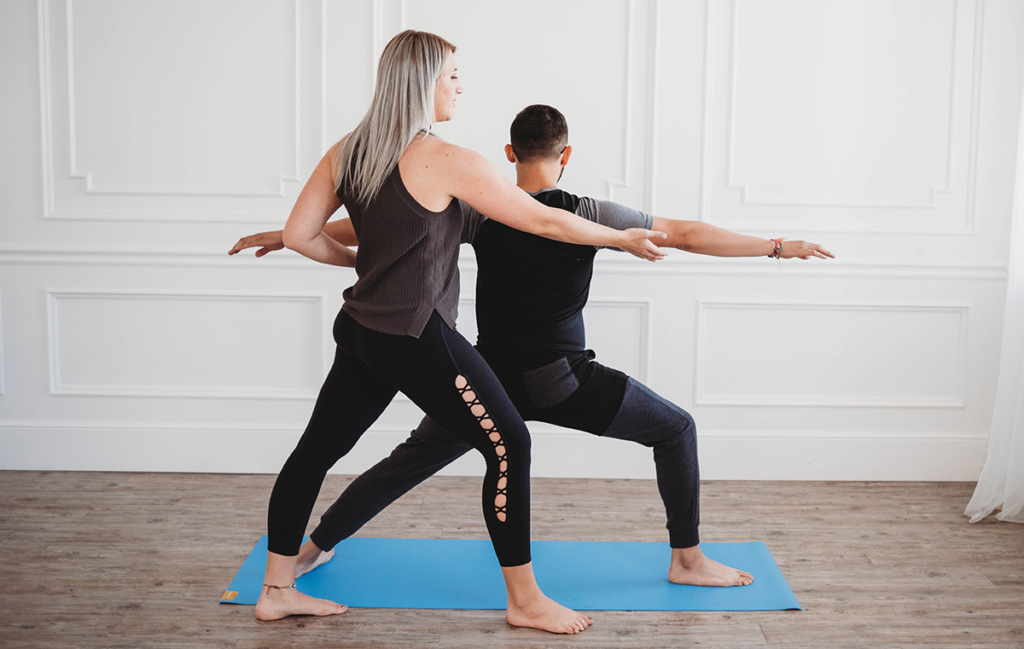
For my first 10 years of yoga teaching, I followed popular alignment orthodoxy. In standing poses such as Trikonasana (Triangle Pose) and Virabhadrasana II (Warrior II Pose), I instructed students to square their hips to the front. I learned this instruction from a series of experienced teachers. They learned it from their even more experienced teachers. Then one day, while practicing Warrior II on a mindfulness retreat, I discovered a better way. I realized that allowing my pelvis to turn along with my legs made my pose way more stable. I’d always felt shaky and weak in Warrior II, and could barely hold it for 30 seconds. When I let my pelvis rotate with my legs, I could rest easily in the pose for a minute or two. Then later, I learned about other potential problems that could arise from squaring the hips in standing poses. As a result, I had to retract 10 years of emphatic instruction. But my commitment to truth was more important than saving face.
Gandhi said, “My commitment is to truth, not consistency.” My mindfulness teacher, Pujari, has quoted this many times in the context of his teaching. I’ve just begun to understand the profound importance of this concept. Yoga teachers, and teachers and experts of all disciplines, can benefit from pondering the meaning.
The Scientific Commitment to Truth
COVID has provided us with lots of examples. For instance, anti-maskers I know have criticized Dr. Anthony Fauci for inconsistency in masking instructions. Early in the pandemic, March 2020, he advised citizens not to wear masks. He did so because masks were in short supply at the time. Health care workers were having to reuse them or go without, at great potential peril. When masks became more available, he revised his recommendations. This is because his field of expertise, science, pursues truth, not hard-and-fast rules.
Recommendations should change when a situation changes. In fact, official recommendations in the time of COVID have changed many times. It is a “novel” coronavirus after all. I consider this inconsistency to be a positive, because it means that experts are following the truth where it takes them instead of sticking to wrong information in order to save face. In other words, they have a commitment to truth, not consistency.
Commitment to Truth in Yoga Teaching
Teaching yoga would be so easy if there were hard-and-fast alignment cues that worked for everyone. But the truth is, we all come into the world with different genetics. Then as we live, our bodies and minds mold themselves to our unique lives. No two individuals’ practices will ever be the same. For long-term practitioners, if we have a commitment to truth, our practice will change over time as well.
Different schools of yoga have, at times, preached consistency with regard to various yoga practices. For example, I’ve heard some teachers claim that practicing a certain type of pranayama x number of times will produce y result. The system I grew up in, the Iyengar method, encouraged squaring the hips in standing poses, at least for a number of years. The Anusara system taught “Universal Principles of Alignment” designed to apply to everyone in every pose.
One of the things I admired about B.K.S. Iyengar is that no matter how emphatic he was about certain alignment instructions, he was willing to modify or even toss them out when he discovered better information. I was certified in the Iyengar system in 1989, shortly after returning from studying at the Ramamani Iyengar Memorial Yoga Institute in Pune, India. This was fortuitous, because the senior teachers who assessed my teaching skills knew I had the latest information. They were anxious to know what I’d learned, because they knew there would be some new discovery, or some instruction that was no longer relevant. The method was in a constant state of flux. That a teacher of Iyengar’s stature could so easily toss away his own alignment principles demonstrated his commitment to truth.
Changing Your Mind is a Good Thing
If you teach yoga long enough, you will likely, at some point, learn that instructions you may have seen as gospel were not so helpful in retrospect. As with my revelations about squaring the hips—and countless other instructions as well—if you’re being truthful with yourself, you’ll likely need to tweak your teaching. It’s important to remember that the teachers who gave you those less-than-helpful instructions were giving you the best information they had at the time. And you were, in turn, offering your students the best information you had. Castigating yourself or blaming your teachers is not helpful. Flexibility in the body is not nearly as helpful as flexibility of mind when it comes to teaching yoga. Changing your mind is not a sign of weakness. It’s a sign of your commitment to truth, not consistency.
Teaching from Truth Requires Mindful Practice
In order to delve into the truth, we must practice. And we must practice mindfully. This means we need to approach our practice each day with beginner’s mind. When we practice with an open mind, we’re far more likely to move beyond what we think we know and touch into the truth. No matter how many times you’ve practiced Triangle Pose or Warrior Pose, each time you practice it’s a whole new pose. What can you learn from your practice today?
